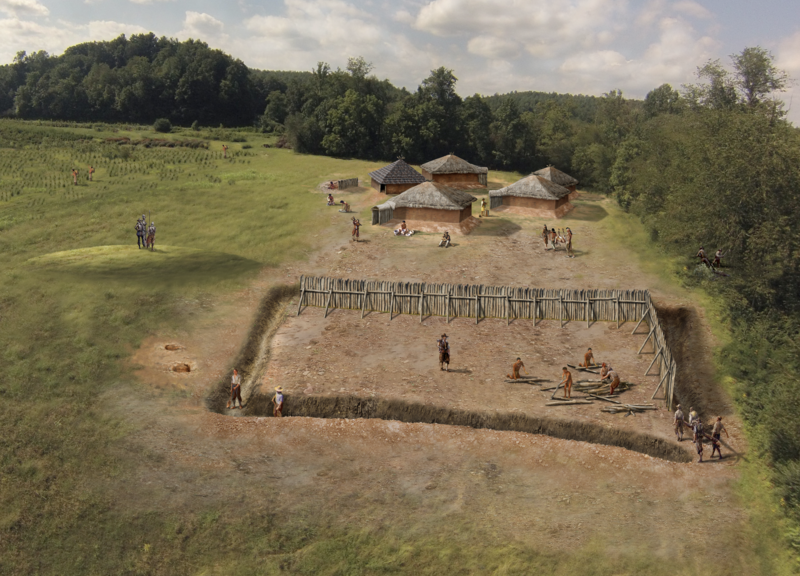Spanish Armor Plate Discovered in North Carolina, U.S.A
Spanish soldiers took over the Native city of Catwba, Joara, about 60 miles east of Asheville, on an excursion from Florida about 450 years ago.
Fort San Juan is the first known European settlement to be established in the south-east of the USA about fourteen years before the British came to Jamestown. In Appalachia, Spanish became the first European language.
The story of Spanish soldiers coming to Catawba is, like much of American colonial history, characterized by colonization and ethnocentrism.
David Moore, an archeology teacher at Warren Wilson College, said: “There’s this sense of who is the other,” For nearly three decades Moore has been the executive archeologist, who has been leading research and excavations at the Barry site. Fort San Juan was about the size of a modern-day basketball court. He says the remains of the structure are more intact than any other colonial fort in North America.

“In effect, it’s 100 percent intact. We have the entire outline of it,” Moore said. “Unfortunately, plowing over the years has destroyed the upper levels of it, but it’s still far more intact than any other Spanish colonial fort. “
When Spanish explorer Captain Juan Pardo and his men arrived in 1566, they declared the Catawba Indians, who didn’t speak their language, new subjects of the king. The Spaniards forced the natives to construct the soldier’s homes and provide them meals. While the two groups lived side-by-side, the relationship was fraught by mounting mistrust and resentment.
“So this relationship of two groups understanding each other very poorly, trying to figure out what to do with the other was constantly in the air,” Moore said.
The tension ultimately propelled the Catawba to force the Spanish army out, changing the course of American history. The absence of the Spaniards allowed for English colonists to move inland and take their place. It’s how the English language gained a foothold in the region.
“That colonial experience continued to be detrimental for native peoples,” Moore said. “The effects of the slave trade, of diseases, and of the political, economic and social disruption of tribal groups that ended up collapsing a social and political system that had been in place for nearly a thousand years.”
There’s one particular artifact Moore’s team found that offers a snapshot of the Spaniards’ suspicion — and superstition.
“We found a small piece of scrap metal, almost square in shape, and about an inch and a half in diameter,” Moore said. They discovered it was a small plate of armor, the kind that was sewn into garments during the medieval period. It was placed vertically in the soil, next to a post in the framework of a Spanish soldier’s house.

Moore and his team were perplexed by the armor until one historian reached out offering multiple references in Medieval European literature. Metal objects were commonly placed in the frames of homes to fend off black magic.
“A Spanish soldier had placed this in the building to ward off witches, especially because Indian women were feeding them,” Moore said. “Many people think of native peoples being uncivilized, but here we have modern Europeans employing this kind of folklore to ward off magic.
That wasn’t lost on Catawba Indian Beckee Garris when she first learned about the Spaniard’s supernatural object. “I kind of laughed, because, in all cultures, there’s a bad person, or a particularly bad spirit, if you want to call it that,” Garris said.
Garris is a storyteller. She also makes Catawba pottery, much like the fragments scattered across the archaeological site. Garris says she makes pots the same way her ancestors did 500 years ago — without a kiln and with clay harvested from the same spot.
“It not only touches my heart, but it also touches my soul that our buried history is coming to light again. We are learning about ourselves now as well about our past,” Garris said. “Before European contact, there was no written history. Everything was passed down orally, and you had to hide who you were because of prejudices and laws that were made by the government.”

Bringing visibility to these early American stories still is a work in progress. The English settlers’ arrival in Jamestown exactly 400 years ago is commonly seen as the beginning of European colonization in the US.
“This is something that we struggle within the US. White folks are not the first folks to have been here,” Paul Worley, Western Carolina University associate professor of global literature, said. He recently took students from Latinx Studies composition and literature classes to the excavation site.
“Given the current moment in the United States, I think it’s a fairly radical thing to go back and talk about these histories,” Worley said. “Both on the Native American side and both on the Spanish colonial side. Because these are both histories that are frequently denied or ignored altogether.”
Worley wants students to think about US history from a multicultural and multilingual perspective – to consider writings from Spanish explorers, Native Americans and enslaved Africans. And maybe, he says, resurrecting those narratives will reframe the retelling of America’s story, both past, and present.
For the archaeologist, there are still lessons to be learned from the Joara-Fort San Juan site. “450 years ago this tragedy unfolds because people don’t acknowledge the humanness of each other. That’s certainly a lesson we’re still trying to learn today,” David Moore said.
